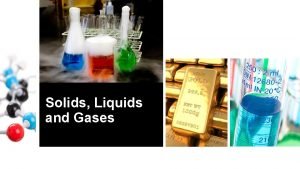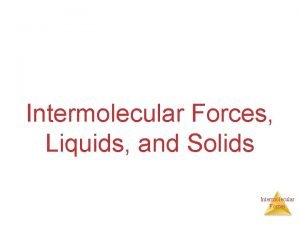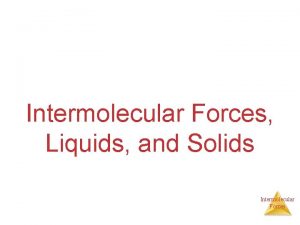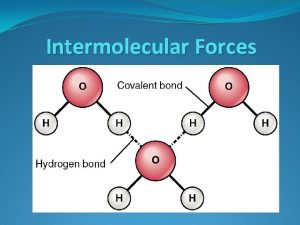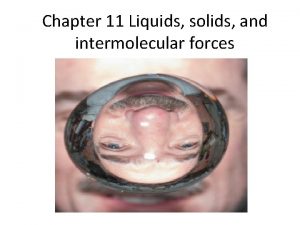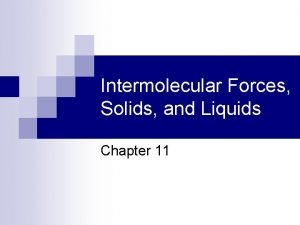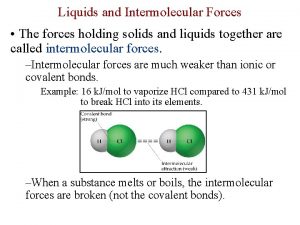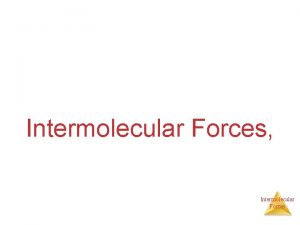Intermolecular Forces and Liquids and Solids Chapter 12




















- Slides: 20

Intermolecular Forces and Liquids and Solids Chapter 12

Tokay gecko.

Geckos can cling to surfaces such as walls and ceilings because of intermolecular interactions called van der Waals forces. • Gecko feet have tiny hairs that split many times to make many very fine tips, giving the hairs a very large total surface area. • The fine hairs are able to form many contacts with any surface, and the surface-to-hair contact is adhesive due to van der Waals forces. • A gecko can support its entire body weight from a wall with only one toe. • One gecko foot can support the weight of an entire human. Tokay Gecko inverted on glass panel. Scanning electron microscope image of a gecko’s toe.

• Van der Waals attractions work because at close range, atoms and molecules notice each other's dipole moments. • The dipole moments are due to the fact that at any given instant, the electron cloud is not evenly distributed over a molecule (or atom). • Even for a nonpolar molecule or a single atom, the electron distribution will not be symmetrical at a given instant (although it will be centered on average). • This instantaneous dipole moment causes atoms (or molecules) in the vicinity to arrange their instantaneous dipoles so as to lower their energy, which causes attraction.

The fundamental difference between states of matter is the distance between particles (atoms or molecules).

12. 1

States of Matter Because in the solid and liquid states particles are closer together, we refer to them as condensed phases.

The States of Matter • The state a substance is in at a particular temperature and pressure depends on two antagonistic entities: – The kinetic energy of the particles – The strength of the attractions between the particles

Intermolecular Forces Intermolecular forces are attractive forces between molecules. Intramolecular forces hold atoms together in a molecule (chemical bonds). 12. 2

Intermolecular Forces Intermolecular forces are attractive forces between molecules. Intramolecular forces hold atoms together in a molecule. Intermolecular vs Intramolecular • 41 k. J to vaporize 1 mole of water (inter) • 930 k. J to break all O-H bonds in 1 mole of water (intra) “Measure” of intermolecular force The attractions between molecules are not nearly as strong as the intramolecular attractions (bonds) that hold compounds together. boiling point melting point DHvap DHfus DHsub 12. 2

Intermolecular Forces Dipole-Dipole Forces Ion-Dipole Forces Dispersion Forces The Hydrogen Bond 12. 2

Intermolecular Forces Dipole-Dipole Forces Attractive forces between polar molecules Polar molecules orient to maximize attractive interactions. 12. 2

Intermolecular Forces Dipole-Dipole Forces Attractive forces between polar molecules 12. 2

Intermolecular Forces Ion-Dipole Forces Attractive forces between an ion and a polar molecule Ion-dipole interactions allow ionic substances to dissolve in polar solvents. 12. 2

Ion-Dipole Forces Charge and size of ion Magnitude of dipole moment and size of molecule Strongest interaction – high charge, small ionic radius (i. e. , high charge density) 12. 2

Will a cation or an anion (of equal charge) make the stronger ion-dipole interaction with water? Explain. Cation, because it is smaller. For two ions with equal but opposite charge, the cation will exhibit the greater charge density because it is smaller. 12. 2

Intermolecular Forces Dispersion Forces (London forces) Attractive forces that arise as a result of temporary dipoles induced in atoms or molecules that are otherwise nonpolar These forces are present in all molecules, whether they are polar or nonpolar. ion-induced dipole interaction dipole-induced dipole interaction instantaneous dipole-induced dipole interaction 12. 2

Intermolecular Forces Dispersion Forces (London forces) Attractive forces that arise as a result of temporary dipoles induced in atoms or molecules Spherical charge distribution in a helium atom. ion-induced dipole interaction dipole-induced dipole interaction 12. 2

Intermolecular Forces Dispersion Forces (London forces) Attractive forces that arise as a result of temporary dipoles induced in atoms or molecules Instantaneous dipole-induced dipole He atom 2 produces an instantaneous dipole that induces a dipole in neighbouring He atom 1. 12. 2

Intermolecular Forces Dispersion Forces (London forces) Attractive forces that arise as a result of temporary dipoles induced in atoms or molecules Instantaneous-induced dipole The strength of dispersion forces tends to increase with increased molecular weight. Larger atoms have larger electron clouds, which are easier to polarize. The tendency of an electron cloud to distort in this way is called polarizability. 12. 2
 Intramolecular forces vs intermolecular
Intramolecular forces vs intermolecular Intra vs intermolecular
Intra vs intermolecular Intramolecular forces vs intermolecular forces
Intramolecular forces vs intermolecular forces Chapter 14 solids liquids and gases worksheet answers
Chapter 14 solids liquids and gases worksheet answers Kinetic molecular theory of solid
Kinetic molecular theory of solid Chapter 11 - states of matter: liquids and solids
Chapter 11 - states of matter: liquids and solids Thermal expansion and contraction examples
Thermal expansion and contraction examples Solids liquids and gases section 2 properties of fluids
Solids liquids and gases section 2 properties of fluids Solid liquid and gas molecules
Solid liquid and gas molecules Solid liquid gas venn diagram
Solid liquid gas venn diagram What are the properties of solid
What are the properties of solid Examples of solids liquids and gases pictures
Examples of solids liquids and gases pictures Adhesive force
Adhesive force Liquids and solids menu
Liquids and solids menu The science duo physical and chemical changes
The science duo physical and chemical changes Liquids and solids
Liquids and solids Particle movement in solids liquids and gases
Particle movement in solids liquids and gases How does sound travel through solids liquids and gases
How does sound travel through solids liquids and gases Matter and its composition
Matter and its composition Motion of particles in solids, liquids and gases
Motion of particles in solids, liquids and gases Gases are easily compressed because of the
Gases are easily compressed because of the















